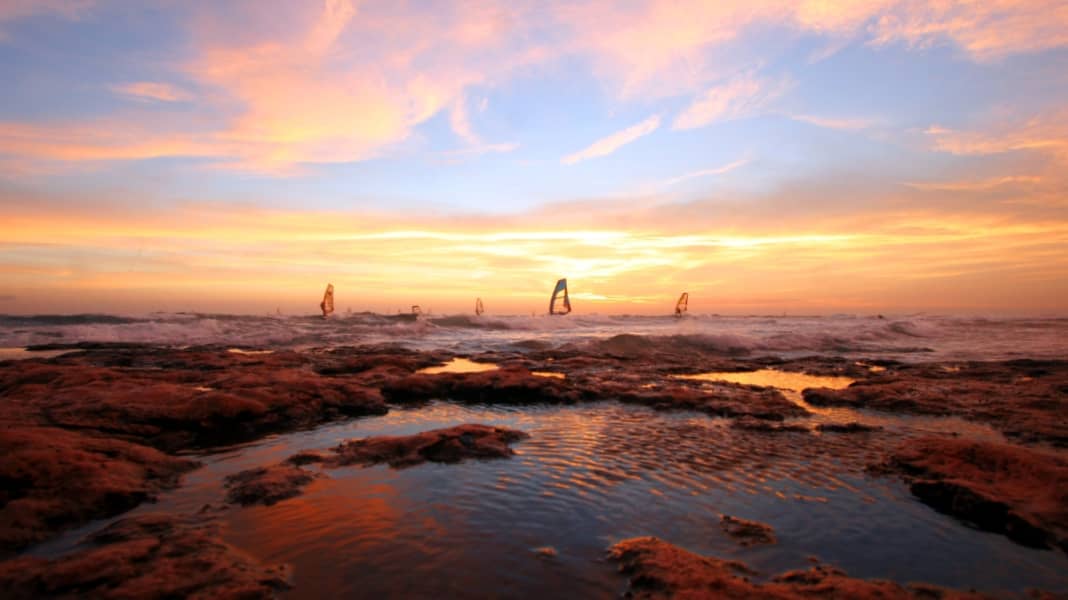
Wolfgang, every windsurfer enjoys the summer, but the sun's rays are often very strong, especially on the water. What is particularly important in summer?
You should start applying sun cream early in the day. There is no point in applying sun cream before surfing in the afternoon if you have already spent the whole morning in the sun without protection. You need to know this: The skin can tolerate a certain dose of sun without protection, then the quota is used up. After that, applying sun cream is of little use. So if you are in sunny areas and want to go out on the water in the afternoon, you should protect yourself early in the morning, e.g. by putting on a hat and applying sun cream.
So do you have a certain amount of sun that you can use up before your skin is damaged?
Exactly. Every skin is different and can withstand different amounts of sun. This self-protection can then be extended with a good sun cream. The higher the sun protection factor of the sun cream, the longer you can spend in the sun without damaging your skin.
Does this apply under ideal conditions or also on the water?
Protection is always reduced in water, as the cream unfortunately washes off. "Waterproof" therefore does not mean that the cream stays on the skin indefinitely. Ideally, the protection should be refreshed several times a day, especially in water or when sweating heavily. I would bring my sun cream with me when I go on holiday abroad. In Germany, such products are certified: So you know what's in them (important for allergy sufferers) and they work reliably.



What can you do if you get too much sun?
Minor reddening of the skin usually goes away on its own the next day if you moisturise the skin well in the evening (aftersun cream). The second stage is the formation of blisters, in which case applying cream the next day is of no use. The only thing that helps is to get out of the sun and dress in such a way that the affected areas of the body remain UV-protected (Lycra shirt). If the skin is severely reddened, it is damaged to such an extent that it can no longer fulfil its protective function, i.e. protection against infection or mechanical stress. Anyone who has ever carried a rucksack on burnt shoulders knows what is meant. It is important to drink plenty of fluids, as this improves the regeneration of the stressed body and also the skin. Plenty of aftersun cream is helpful, as the skin is less tight and regains moisture. Nutrition can also support the regeneration of sun-damaged skin.
What is important here?
Food rich in vitamins, especially vitamin A, is helpful. Apples or carrots are ideal. Conversely, consuming alcohol or too much coffee is counterproductive, as this also dehydrates the body. Of course, there is nothing wrong with a beer after the session, as long as you drink enough non-alcoholic fluids.
What else should you consider in summer?
What we see time and again is what is known as heat exhaustion: you sweat from every pore, your pulse increases and you get slight circulatory problems, e.g. in the form of dizziness. This exhaustion can also occur if, for example, you are still wearing your thick winter neo on a warm spring day and are cooking in your own soup. In this case, the only thing that helps is to drink plenty of fluids and get out of the sun. If you don't get out of the sun during this phase, you can get heatstroke. Your circulation collapses, you quickly develop a high temperature and stop sweating because all the fluids have been sweated out. Then only the emergency doctor can help.
Let's be honest - have you ever experienced something like this yourself?
I've personally experienced this while surfing in the south of France, where a surfer had a heat stroke and collapsed. I gave him fluids via the vein and accompanied him to hospital. This is a realistic risk, especially on surfing holidays in the tropics.
Is heat exhaustion the same as sunstroke?
No, sunstroke is a consequence of the sun shining on your uncovered head for too long. This can also happen when it is less hot and you are not sweating at all. You then get a headache as a sign of irritation of the skin surrounding the brain and swelling of the brain. If nausea and signs of confusion and drowsiness are added to this, it becomes life-threatening. The same applies here: drink plenty of fluids and wear a hat or cap on the water as a precaution. Men with thinning hair are particularly affected. I can tell you a thing or two about it myself.
Thank you Wolfgang for the interview and have a great summer!
Also interesting:

